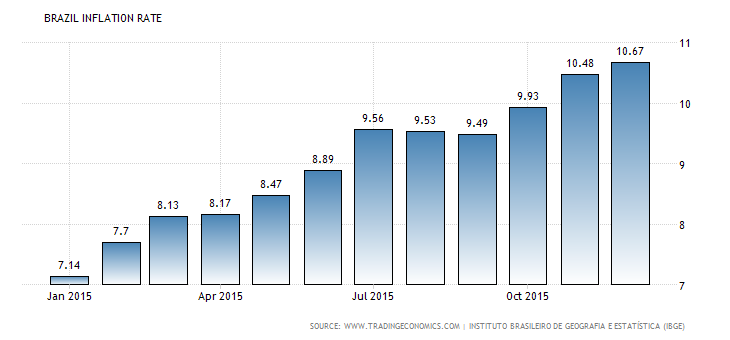Monetary policy and inflation targeting
Syllabus: Explain that central banks of certain countries, rather than focusing on the maintenanceof both full employment and a low rate of inflation, are guided in their monetary policy by the objective to achieve an explicit or implicit inflation rate target.
Most countries choose to aim for a target range for the inflation rate and use monetary policy only when that range is likely to be exceeded. In USA the Fed nowadays is also concerned with low unemployment so quantitative easing is used when unemployment becomes an issue. In Brazil the target Inflation Rate is 2.5% to 6.5%. However according to Trading Economics:

so the target is well-exceeded at the moment of writing (Jan 2016)
Flexible inflation targeting
Norges Bank operates a flexible inflation targeting regime, so that smoothing fluctuations, both in inflation and in output and employment, is given weight in interest rate setting. Flexible inflation targeting builds a bridge between the long-term objective of monetary policy, which is to keep inflation low and anchor inflation expectations, and the objective of smoothing developments in output. Expectations regarding future interest rates play an important role for developments in output, employment, incomes and inflation. Through its interest rate forecasts, Norges Bank influences the interest rate expectations of market participants, enterprises and households.
Interest rate forecasts should satisfy the following main criteria:
- The interest rate should be set with a view to stabilising inflation at target or bringing it back to target after a deviation has occurred. The relevant time horizon will depend on the type of disturbances to which the economy is exposed and their effect on the path for inflation and the real economy ahead.
- The interest rate path should, at the same time, provide a
reasonable balance between the path for inflation and the path for
overall capacity utilisation in the economy.
In the assessment, potential effects of asset prices, such as property prices, equity prices, and the krone exchange rate on stability in output, employment and inflation are also taken into account.
Assuming the criteria above have been satisfied, the following additional criteria are useful:
- Interest rate adjustments should normally be gradual and consistent with the Bank's previous response pattern.
- Interest rate developments should result in acceptable developments in inflation and output also under alternative assumptions concerning the economic situation and the functioning of the economy. Any substantial and systematic deviations from simple, robust monetary policy rules should be explained.
- The interest rate forecast is an expression of Norges Bank's overall judgement and assessment based on the criteria above. Usually, the criteria cannot all be satisfied simultaneously, and the various considerations must therefore be weighed against each other. Forecasts of the key policy rate and other economic variables are based on incomplete information concerning the economic situation and the functioning of the economy. Should developments in the economy differ from assumptions or should the central bank change its view of the functioning of the economy, developments in the interest rate and other variables may deviate from the forecasts

The websites of many of the world's Central Banks can be found here: